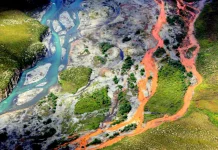Most of the time, the Atacama desert — the driest non-polar place on Earth, sandwiched between two mountain ranges in western Chile — is gritty, cracked, and red. The desert gets less than 1.5 centimeters of rain per year, the equivalent of six or so hours of drizzle. Sometimes it doesn’t get any at all. But this year… It’s different:

Other years, though, are just a little bit damper. In those cases, the seeds sleeping just under the sand wake up, sending shoots to the surface. Those shoots grow leaves and buds. And then, when the time is right, the whole desert lets loose. This is one of those years.
Hoy en #MiércolesDeLaTierra una hermosa imagen del Desierto Florido ,en Atacama, Chile. Una maravilla de la Naturaleza… Por esta belleza y mucho más cuidemos nuestro Planeta! ?@BoseOfficial #MB pic.twitter.com/Aijy4DKQgg
— M.Bose toda una vida (@MBTodaunavida) April 17, 2019
Intense and unexpected rain in the north of Chile has brought another “desierto florio,” or “desert flowering,” to parts of the Atacama.
Invierno altiplánico provoca singular desierto florido en la Región de Arica y Parinacota . CONAF llama a visitantes a ser respetuosos, “no corte las flores y evite pisar el terreno florido”. Los antecedentes en T13 https://t.co/OoR96ep5hn pic.twitter.com/moEHyvaDut
— CONAF (@conaf_minagri) March 31, 2019
Although the desert usually experiences a flowering every five to seven years, this one comes just two years after the last, which pinkened the landscape with field upon field of mallow flowers.
•Desierto Florido;
— Thomas ama a su solcito Sebastián. (@benkxvich) February 3, 2019
Ubicado en la Región de Atacama, Norte de Chile. pic.twitter.com/R3YJYl6DCm
So far, this year’s palette leans heavy on white, purple, and yellow.
Sin embargo, el fenómeno conocido como “El Desierto Florido”, se da justamente en este territorio supuestamente inerte. En la Región de Atacama, Chile. Eso hace doblemente asombroso el dato. pic.twitter.com/pp2jbvIRYo
— Ademir Ríos (@NegroAde) February 5, 2019
Tourism officials said that they hope to see even more colors soon, as the various seeds take different amounts of time to germinate. The desert has more than 200 plant species.
In the meantime, botanists are flocking to study what they can, and tourists are close behind, for beauty, and wonder.












